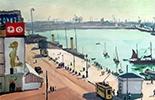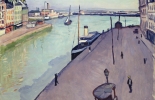Marquet in Normandy
from April 22 to September 24, 2023
Following “Pissarro in the Ports” in 2013 and “Raoul Dufy in Le Havre” in 2019, MuMa continues its series of exhibitions devoted to artists who spent time in Le Havre and other Norman locations with a close look at Albert Marquet’s Norman output. As with the previous exhibitions, “Marquet in Normandy” provides an opportunity to reflect on the themes of series and viewpoints in the artist’s work.
Harbours are ubiquitous in Marquet’s oeuvre. They were where he applied his formal simplification to shapes already blurred by reflections in constantly-moving water and chance weather conditions such as mist effects. .
MuMa’s exhibition “Marquet in Normandy” will present around 60 paintings and drawings from prestigious French and foreign public and private collections, exhibited together for the first time. Artworks by friends of Marquet including Dufy, Matisse, Friesz, Camoin and Valtat will form a counterpoint to them.
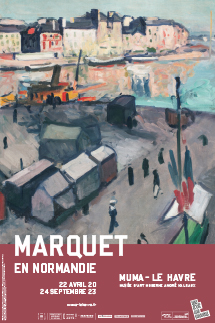
Marquet's stays in Normandy :
1903 : La Manche (La Percaillerie)
1906 : Le Havre, Fécamp, Trouville, Honfleur
1911 : Honfleur
1912 : Rouen
1927 Honfleur, Vieux Port, environs de Rouen (Canteleu, Croisset, Dieppedalle, La Mailleraye-sur-Seine)
1934 : Le Havre
1937 : Dieppe
“I can’t write or speak, only paint and draw. Look at what I’ve done. Either I’ve succeeded in expressing myself or I’ve failed. In any case, should you not understand, be if by your fault or mine, I can do no more.”
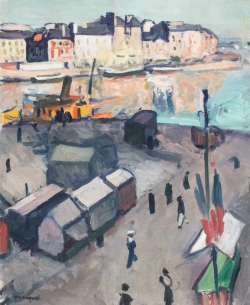
Albert MARQUET (1875-1947), Le Havre, le bassin, 1906, oil on wood, 61.4 x 50.3 cm. . © MuMa Le Havre / Charles Maslard
Today, Albert Marquet (1875–1947) is particularly well represented in MuMa’s collections, with no fewer than 14 paintings and 23 drawings.
This is not so much the result of purchases by successive curators - apart from Le Havre, le bassin (Le Havre Harbour Basin), 1906), only L’Avant-port du Havre (The Outer Harbour of Le Havre), 1934, was purchased with the museum’s funds - as of the artist’s popularity, beginning in the early twentieth century, with Le Havre art-lovers who subsequently donated their collections to the museum - in particular the collectors who founded the Cercle de l’Art Moderne in 1906..
Marquet came to Le Havre on several occasions, both to paint and to exhibit his work. This facilitated connections with collectors, some of whom purchased many of his works. The first Fauvist pictures by Marquet to join Le Havre’s municipal collections were those in Charles Auguste Marande’s 1936 bequest – Le Port de la Ponche à Saint-Tropez (La Ponche Harbour in Saint-Tropez), Quai de la Seine à Paris (Quay of the Seine in Paris) and Vue d’Agay, les rochers rouges (View of Agay, The Red Rocks). Another local collector, Olivier Senn, whose granddaughter donated his collection to MuMa in 2014, purchased as many as 15 paintings and numerous
drawings. Peter van der Velde and Georges Dussueil (who possessed no fewer than 13 of his pictures) were also great admirers of Marquet’s painting.
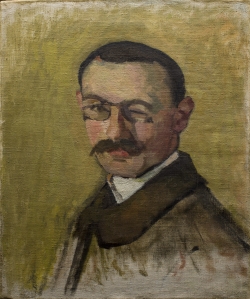
Albert MARQUET (1875-1947), Autoportrait, 1904, oil on canvas, 46 x 38 cm. . © Mairie de Bordeaux musée des Beaux-Arts/Frédéric Deval
So it seemed natural that Muma should devote an exhibition to Albert Marquet, focusing on a hitherto unexplored section of his output – his stays in Normandy.
Marquet is one of those artists whose oeuvre remains relatively little known to the general public, partly because of his retiring personality. He was a reserved character who cared nothing for honours. As he himself confessed, “I can’t write or speak, only paint and draw. Look at what I’ve done. Either I’ve succeeded in expressing myself or I’ve failed. In any case, should you not understand, be if by your fault or mine, I can do no more.”
Not especially inclined to study and naturally shy, from an early age, Albert Marquet took refuge in drawing. His love of maritime settings probably stemmed from his early upbringing. He was born in Bordeaux in 1875, and spent his free time on the city's quays and his holidays in the bay of Arcachon.
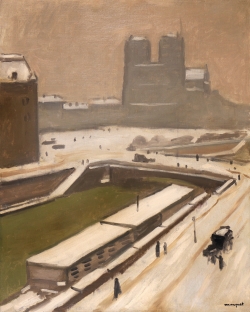
Albert MARQUET (1875-1947), Notre-Dame de Paris sous la neige, 1916, oil on canvas, 81 x 65 cm. . © Courtoisie Galerie de la Présidence - Paris
In 1894, he enrolled at the École Nationale des Beaux-arts and joined Matisse in Gustave Moreau’s studio. Yet his friend Francis Jourdain, also a painter, saw Marquet as self-taught, as if Gustave Moreau’s teaching had made no mark on him.
“He is indebted to nothing but his understanding – his understanding of the masters, his understanding of his job, his understanding of the street and the city.”
ALBERT MARQUET'S STAYS IN NORMANDY
Albert Marquet was an indefatigable traveller, zig-zagging the coast of Normandy first at the invitation of Henri Manguin, then with Raoul Dufy, Henri Matisse, Paul Signac and Félix Vallotton, on seven trips between 1903 and 1937, during which he stayed in Flamanville, Le Havre, Fécamp, Trouville, Honfleur, Rouen, Vieux-Port and Dieppe.
The area offered a field for his experiments in colour and the subjects he painted throughout his life, in Normandy and beyond: the maritime world, harbours and the human activities connected with them, the beach, boats, and above all water - a predilection that went back to his childhood in Bordeaux.
Marquet was a studio outdoor painter: he painted from his window. It was in Normandy that he invented his formula of a landscape viewed from high up, away from curious onlookers, with an eye for framing, simplified shapes and a very sure colour sense.
1903 : La Manche (La Percaillerie)
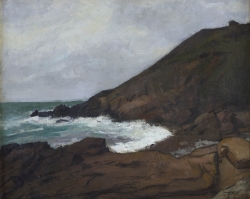
Albert MARQUET (1875-1947), Les Falaises de Flamanville,, 1903, oil on canvas, 50 x 60 cm. . © Région Normandie / Inventaire général/Patrick Merret
Marquet was one of the Fauvists - a group that included Camoin, Derain, Dufy, Manguin, Matisse and Vlaminck - whose pictures created a furore, with their large flat blocks of pure colour, when they were exhibited in the Salon d’Automne of 1905. Yet Marquet, who, together with Matisse, had experimented with a Fauvist manner as early as 1898, was one of the most moderate of the Fauvists.
1906 : Le Havre, Fécamp, Trouville, Honfleur
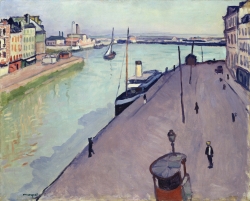
Albert MARQUET (1875-1947), Le Havre, 1906, oil on canvas, 65 x 81 cm. . © Fondation collection Emil Bührle - Zurich/Kunsthaus Zürich
Both friends used the locations to experiment with pictorial techniques and use of colour, but in Marquet’s work, the boldness of the Fauvist period gradually gave way to formal simplification.
1911 : Honfleur
1912 : Rouen
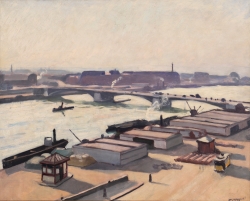
Albert MARQUET (1875-1947), Rouen, le pont Boieldieu et le quai de Paris par temps ensoleillé, 1912, oil on canvas, 63 x 80 cm. Private collection. © Courtoisie Galerie de la Présidence - Paris
1927 : Honfleur, Vieux-Port, environs de Rouen (Canteleu, Croisset, Dieppedalle, La Mailleraye-sur-Seine)
1934 : Le Havre
1937 : Dieppe
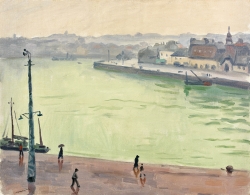
Albert MARQUET (1875-1947), Le Port de Dieppe, 1937, oil on canvas, 46 x 60 cm. Private collection. © Courtoisie Artcurial - Paris
In September 1934, he spent three weeks in Le Havre, staying at the Hôtel Continental, overlooking the harbour entrance - the very spot from which, 32 years earlier Pissarro had painted a now vanished setting.
In 1937, he came back to Normandy for a final visit, during which he produced a number of paintings, including views of Dieppe harbour..
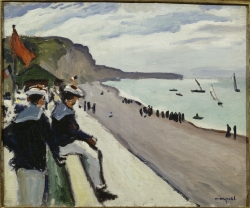
Albert MARQUET (1875-1947), La Plage de Fécamp, 1906, oil on canvas, 50 x 61. . ©RMN-Grand Palais/ Philipp Bernard
His stays in Normandy also illustrate how his use of colour evolved. While, as of 1906, in his few Fauvist landscapes, city streets decked with flags and colourful advertising posters, he uses pure colours arbitrarily, although their violence is contained – from 1911, he uses a calmer spectrum of colours that gives way to subtle grey monochromes. For Marquet, the landscape is a vehicle for the emotions, a stimulus to the imagination and a means of experimenting with colours, drawing and composition - something that is perhaps especially well illustrated by his Norman series.
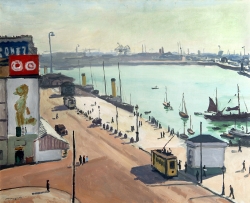
Albert MARQUET (1875-1947), Le Quai du Havre, 1934, oil on canvas, 65 x 81 cm. . © Musée des Beaux-Arts de Liège/La Boverie
He endeavoured to simplify lines, to condense and reduce to the essentials. “When he worked, he eliminated certain details, only keeping a few lines, and you realized afterwards that he had succeeded in choosing those that sufficed to express both his object and his own emotion.” (Marcelle Marquet, op.cit.)
Annette Haudiquet, Director of MuMa (retired as of 31 January 2023) and Chief Heritage Curator.
Exhibition curators :
Sophie Krebs, General Heritage Curator and exhibition curator of the 2016 Marquet retrospective at the Musée d’Art moderne de Paris,
Michaël Debris, Exhibitions Coordinator at MuMa
With the help of the Advisory Board of the Wildenstein-Plattner Institute, which is working on a catalogue raisonné of Marquet’s work.
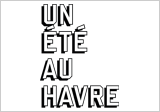
Organized as part of the “Un Été Au Havre” events programme
MORE +
Publications
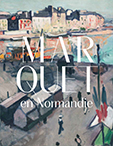
Catalogue
MuMa musée d’art moderne André Malraux, Le Havre, 22 april - 24 september 2023
Authors : Annette Haudiquet, Sophie Krebs, Itzhak Goldberg, Michaël Debris, Bernard Plossu
Publication : Éditions Octopus / MuMa Le Havre, 232 pages, 190 illustrations, 30 €, Hardcover, in French
ISBN : 978-2-900314-38-3


